Related Research Articles

A reef aquarium or reef tank is a marine aquarium that prominently displays live corals and other marine invertebrates as well as fish that play a role in maintaining the tropical coral reef environment. A reef aquarium requires appropriately intense lighting, turbulent water movement, and more stable water chemistry than fish-only marine aquaria, and careful consideration is given to which reef animals are appropriate and compatible with each other.
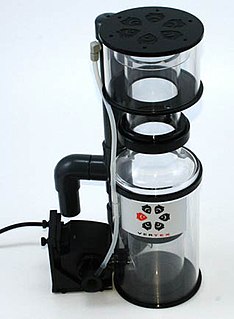
A protein skimmer or foam fractionator is a device used to remove organic compounds such as food and waste particles from water. It is most commonly used in commercial applications like municipal water treatment facilities and public aquariums. Smaller protein skimmers are also used for filtration of home saltwater aquariums.

A marine aquarium is an aquarium that keeps marine plants and animals in a contained environment. Marine aquaria are further subdivided by hobbyists into fish only (FO), fish only with live rock (FOWLR), and reef aquaria. Fish only tanks often showcase large or aggressive marine fish species and generally rely on mechanical and chemical filtration. FOWLR and reef tanks use live rock, a material composed of coral skeletons harboring beneficial nitrogen waste metabolizing bacteria, as a means of more natural biological filtration.
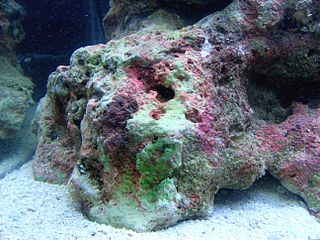
Live rock is rock from the ocean that has been introduced into a saltwater aquarium. Along with live sand, it confers to the closed marine system multiple benefits desired by the saltwater aquarium hobbyist. The name sometimes leads to misunderstandings, as the "live rock" itself is not actually alive, but rather is simply made from the aragonite skeletons of long dead corals, or other calcareous organisms, which in the ocean form the majority of coral reefs. When taken from the ocean it is usually encrusted with coralline algae and inhabited by a multitude of marine organisms. The many forms of micro and macroscopic marine life that live on and inside of the rock, which acts as an ideal habitat, give it the name "live rock".

Fishkeeping is a popular hobby, practiced by aquarists, concerned with keeping fish in a home aquarium or garden pond. There is also a piscicultural fishkeeping industry, as a branch of agriculture.

The common goldfish is a breed of goldfish with no other differences from its living ancestor, the Prussian carp, other than its color and shape. Goldfish are a form of domesticated wild carp and are a close relative of koi. Most varieties of fancy goldfish were derived from this simple breed. Common goldfish come in a variety of colors including red, orange, red/white, white/black, yellow/white, blue, grey/brown/, olive green, yellow, white, and black, with the most common variation being orange. Sometimes, the brightness, duration, and the vividness of the color may be an indication of the fish’s health status.
A deep sand bed is a filtration method used in some saltwater aquariums. A deep sand bed, similar to the Berlin Method, is designed to cultivate anaerobic bacteria in the bottom layers of sand, converting nitrate to nitrogen gas to remove toxic nitrates.
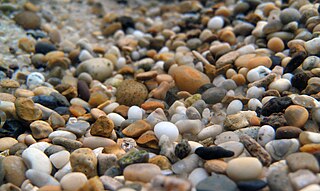
The substrate of an aquarium refers to the material used on the tank bottom. It can affect water chemistry, filtration, and the well-being of the aquarium's inhabitants, and is also an important part of the aquarium's aesthetic appeal. The appropriate substrate depends on the type of aquarium; the most important parameter is whether the aquarium contains fresh water or saltwater.

The narrow-lined pufferfish is a demersal marine fish belonging to the family Tetraodontidae.
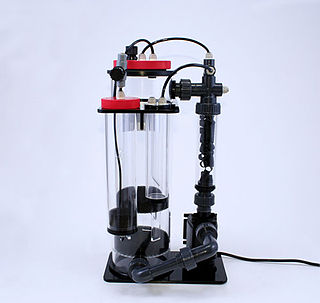
In marine and reef aquariums, a calcium reactor creates a balance of alkalinity. An acidic solution is produced by injecting carbon dioxide into a chamber with salt water and calcium rich media. The carbon dioxide lowers the pH by producing a solution high in carbonic acid, and dissolves calcium. The effluent is returned to the reef aquarium where the calcium is consumed by organisms, primarily corals when building skeletons. A calcium reactor is an efficient method to supply calcium to a reef aquarium. Reactors may be used in elaborate freshwater and brackish aquariums where freshwater clams and other invertebrates need a constant supply of calcium.
In fishkeeping, a refugium is an appendage to a marine, brackish, or freshwater fish tank that shares the same water supply. It is a separate sump, connected to the main show tank. It is a "refugium" in the sense that it permits organisms to be maintained that would not survive in the main system, whether food animals, anaerobic denitrifying bacteria, or photosynthesizers. For some applications water flow is limited in order to protect plants or animals that require slow flow. The refugium light cycle can be operated opposite to the main tank, in order to keep total system pH more stable (due to the uptake of acid-forming CO2 by photosynthesis occurring in the refugium during its "daylight" hours). One volume guideline for a refugium is 1:10 main tank volume.
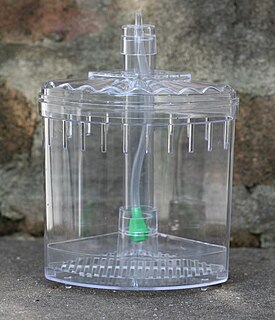
Aquarium filters are critical components of both freshwater and marine aquaria. Aquarium filters remove physical and soluble chemical waste products from aquaria, simplifying maintenance. Furthermore, aquarium filters are necessary to support life as aquaria are relatively small, closed volumes of water compared to the natural environment of most fish.
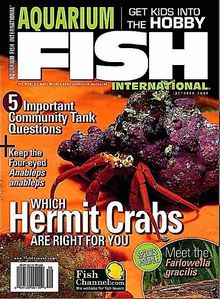
Aquarium Fish International (AFI) was a North American monthly magazine, published by BowTie Inc. of Irvine, California, and dedicated to freshwater and saltwater fishkeeping and the aquarium/fishkeeping hobby in general.

An aquarium is a vivarium of any size having at least one transparent side in which aquatic plants or animals are kept and displayed. Fishkeepers use aquaria to keep fish, invertebrates, amphibians, aquatic reptiles such as turtles, and aquatic plants. The term "aquarium", coined by English naturalist Philip Henry Gosse, combines the Latin root aqua, meaning water, with the suffix -arium, meaning "a place for relating to". The aquarium principle was fully developed in 1850 by the chemist Robert Warington, who explained that plants added to water in a container would give off enough oxygen to support animals, so long as the numbers of animals did not grow too large. The aquarium craze was launched in early Victorian England by Gosse, who created and stocked the first public aquarium at the London Zoo in 1853, and published the first manual, The Aquarium: An Unveiling of the Wonders of the Deep Sea in 1854. An aquarium is a water-filled tank in which fish swim about. Small aquariums are kept in the home by hobbyists. There are larger public aquariums in many cities. This kind of aquarium is a building with fish and other aquatic animals in large tanks. A large aquarium may have otters, turtles, dolphins, and other sea animals. Most aquarium tanks also have plants.
Fishless cycling is a form of "maturing" an aquarium. In this process, ammonia is provided to allow beneficial bacteria to colonize. Fishless cycling can reduce the chance of fish loss resulting from insufficient populations of these bacteria.
Live sand, a term used in aquarism, is natural reef coral sand populated with millions of beneficial bacteria and organisms which aid in the dissolving of organic wastes like ammonia, nitrites and nitrates produced by larger organisms in saltwater aquariums. Live sand can be purchased from aquarium stores, but most hobbyists make their own by seeding dead sand with live sand from other aquarium systems.

In fishkeeping, a sump is an accessory aquarium tank in which mechanical equipment is kept. A remote sump allows for a clutter-free display tank.
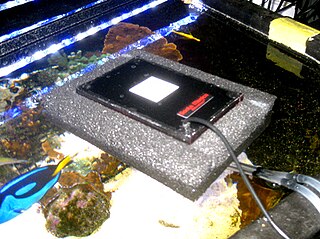
An algae scrubber is a water filtering device which uses light to grow algae; in this process, undesirable chemicals are removed from the water. Algae scrubbers allow saltwater, freshwater and pond hobbyists to operate their tanks using natural filtration in the form of primary production, much like oceans and lakes.
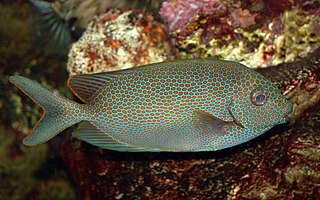
Saltwater fish, also called marine fish, are fish that live in ocean water. Saltwater fish can swim and live alone or live in a large group together, called a school of fish. Saltwater fish are very popular among deep sea fishermen and aquariums all over the country. Saltwater fish are very commonly kept in aquariums for entertainment. Many saltwater fish are also caught to be eaten.